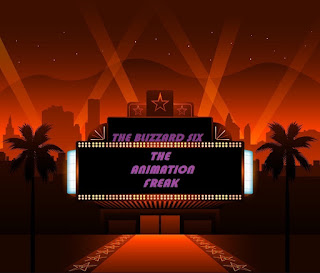The Animation Freak. Soul.
In New York City, Joe Gardner dreams of playing jazz professionally. When he receives an offer for a full-time teaching position, his mother Libba urges him to accept it. Then Joe learns Dorothea Williams has an opening in her quartet and auditions at a music club. Impressed with Joe's piano playing, Dorothea hires him for that night's show. As Joe heads off, his excitement distracts him, and he falls down a manhole and goes down the sewers.
Joe finds himself as a soul heading into the "Great Beyond". Unwilling to die, he tries to escape but ends up in the "Great Before", where counselors—all named Jerry—prepare unborn souls for life with the help of mentor souls. Each soul has a badge which grants passage to Earth once it is completely filled out with personality traits. Mistaken for a mentor, Joe is assigned to train a soul named 22, who desires avoiding Earth. Discovering that Joe is in a coma at a hospital, 22 agrees to let him help find her "spark" to complete her badge and then give it to him so that he can return home. After Joe fails to find 22 a passion, they visit "the zone", a place that souls can enter when their passions create a euphoric trance, but which can also become a trap for obsessed lost souls. They meet Moonwind—a galleon captain—to locate Joe's body on Earth.
Joe returns to Earth but accidentally carries 22, entering their respective bodies of a therapy cat and Joe himself. They find Moonwind, who agrees to meet them later at the jazz club to restore Joe to his body. In the meantime, 22 settles into Joe's body and enjoys small moments while interacting with Joe's peers. She holds poignant conversations with Connie, Dez, and Libba. Meanwhile, Terry sends him to it by arriving on Earth after he was lost, restoring the count.
As the day ends, Joe and 22 rendezvous with Moonwind to return Joe to his body. After Joe tells 22 that her experiences were not purposes, 22 refuses and flees to find her spark, with Joe tailing behind. As they run through a subway station, Terry traps them both and brings them back to the Great Before. 22 realizes her badge is filled out, yet Joe insists it was because of his traits, and that she has not truly found her spark. Angry, 22 throws the badge at him and disappears into the zone. A Jerry informs Joe that a spark is not a soul's purpose in life, but Joe refuses to believe this and uses 22's badge to return to Earth.
The night's show becomes successful, but Joe is upset at his unchanged life even after fulfilling his dream. Looking at objects that 22 collected while in his body, and recalling the moments they had enjoyed together, he sees that these experiences have given 22 her spark. By playing piano, he enters the zone with the intent to return her badge but discovers that she has become a lost soul. He chases her down, showing her a maple seed she had collected to remind her time spending on Earth. They realize that a spark is not a soul's purpose, but indicates an intention to live. Joe's actions restore 22 to normal, returning her badge and escorting her out of the Great Before for her journey to Earth.
As Joe prepares to enter the Great Beyond, a Jerry stops him and offers another chance at life in gratitude for finally inspiring 22 to live. Joe returns to his body on Earth and starts the next day committed to enjoying his entire life.
The development of Soul began in January 2016, when director Pete Docter sought new creative directions during the announcement of the 88th Academy Awards, before eventually pondering the origins of human personalities with the concept of determinism. In his first meeting with co-writer Mike Jones, Docter pitched an idea set in spacetime involving souls with personalities. The film spent four years in production, with an approximate $150 million budget.
Pixar chose to portray the film's main character as a musician because they wanted an appealing profession for the audience, and settled that after trying for a scientist, which did not feel "so naturally pure". Docter described Soul as "an exploration of" things which focused on it. Docter and Jones worked on the development of the main character for about two years. According to Docter, once they settled on the main character being a jazz musician, the filmmakers chose to make it African-American one due to the race tied to jazz history.
With co-writer Kemp Powers's help, he wrote Joe during the film's early development; his 12-week contract was first given and was later extended. He eventually became the film's co-director after his extensive contributions to it, making him Pixar's first African-American co-director. Powers based several elements of Joe on his personal life, but wanted him to "transcend his own experience" in order to make the character more accessible. Powers also placed additional emphasis on authentically depicting the black community as well as Joe's relationships with them. In order to portray accurately African-American culture within the film, Pixar created an internal culture trust composed of black Pixar employees, and hired several consultants, among whom were musicians Herbie Hancock, Terri Lyne Carrington, Quincy Jones, and Jon Batiste; educator Johnnetta Cole; and stars Questlove and Diggs. The filmmakers worked closely with them through the film's development.
The idea for the therapy cat and Joe landing inside its body came from Jones. Docter and Powers appreciated the idea, as it offered the filmmakers a much needed way for Joe to "be able to look at his own life from a different perspective" and appreciate it. According to Murray, the filmmakers were undecided on Soul's ending before the last screening. Some versions of the ending featured Joe preparing whether to pass on to the Great Beyond, to return to Earth a year later, or to stay in the Great Before as a mentor. Several brief scenes showing 22's life on Earth after her new birth, including one of her reuniting with Joe in New York, were storyboarded. Docter considered it very strong for the audiences' decision and ultimately discarded these scenes.
Soul is Pixar's first film to feature an African-American protagonist. Pixar and Docter were mindful at the history of caricatured depiction of African-Americans in animation. They created black characters and integrated African-American culture into the film's "DNA" to remove their caricature, stereotypes, and tropes. According to Powers, the animators used lighting in emphasizing the ethnic diversity. Pixar sought to capture the fine details of the characters, including the textures of black hair and the way light plays on various tones of black skin. Cinematographer Bradford Young worked as a lighting consultant on the film.
Animators used footage of several music performers, including Batiste, performing as reference for the film's musical sequences. By capturing MIDI data from the sessions, animators were able to retrace the exact key being played on the piano with each note and create the performances authentically. According to Docter, the animators assigned to specific musical instruments often either had experience playing them or a great appreciation for them.
The souls were animated by the filmmakers in a "vaporous", "ethereal", and "non-physical" way, based on their designs in definitions about those for various religious and cultural representatives. They differentiated souls from ghosts by adjusting their color palette accordingly. Animating the souls' designs were a challenge by Docter, since the animators had their most substantial work. According to Murray, several artists helped create the souls' designs by giving their suggestions and opinions on how they should look. The designs were also inspired by early drawings made by Docter. Animators created two designs for the souls in the film: one for the new souls in "The Great Before" (described as "very cute, very appealing, with simple, rounded shapes" by supervising animator Jude Brownbill) and one for mentor souls (feature distinctive characteristics since they have been on Earth).
The design of soul counselors ("Jerrys") originated from line drawings made by story artist Aphton Corbin; another one then created wire sculptures of them, upon which it was finalized. Together with the design of "Terry", they were seen by critics as a reference to Osvaldo Cavandoli's 1971 Italian animated series La Linea.
Soul's main aspect was fantasy, representing its broad difficulty. To address the issue, Docter elaborated on making his film Inside Out (2015), determining its personified emotions with clarity and physicality. He also said that having many "very abstract ideas" to the aspect can "bring to life". For the Great Before, the filmmakers did not want it to be based in any specific culture given its nature of universality. They sought inspiration from the architecture of 1930s–1960s world's fairs, making a "sense of awe and importance". In accordance with the film's plot, production designer Steve Pilcher believed the simplicity of the Great Before, saying that it was complicated and naive. According to Docter, the aim of the design was to "make a grand statement about learning and knowledge." The personality pavilions were designed to be "abstract-looking shapes" as a literal interpretation of the abstract ideas they represent. For the Great Beyond, the filmmakers went with a direct take on the concept of "going toward the light", which they believed that the audience understood it.
The astral plane sequence took months to create, despite having its short duration. Visual effects supervisor Bill Watral compared the sequence to Psycho's (1960) shower one. He said that Alfred Hitchcock and his team's reputation for the sequence was longer, as Pixar's filmmakers made attempts in dealing with Soul's cinematography. Without futuristic camera equipment, they sought the usage of creative techniques to accomplish the film's docility. The filmmakers thought the most part of animating the astral plane was to have sands, liquids, and rocks. In this process, the materials were separated, and then integrate their forms again.
For New York, the filmmakers explored jazz clubs and pizza stops for Soul's inspiration. Powers eventually derived the film's scenes from a barbershop, elaborating the family's relationship. The city was distorted and crooked, since it had photorealistic surfaces. Removing sublime computer-generated imagery that caused distortion to any of the film's surfaces.
Musicians Trent Reznor and Atticus Ross of Nine Inch Nails composed an ambient score for the metaphysical segments of the film, while Batiste composed a number of original jazz songs for the New York City-based segments of the film. Batiste sought to create what he referred to as "user-friendly jazz", which felt "authentic" but could still be appreciated by a general audience. Ross felt Joe's musical cue as "somewhat ominous", and also considered having the film DNA-based sounds. Reznor and Ross were brought in on the recommendation of sound designer Ren Klyce, who had worked extensively with the duo in David Fincher films.
The score and the original songs from Soul were released in two separate vinyl-exclusive albums, while also both being compiled onto a digital album. "It's All Right", the end credits song performed by Batiste, was originally recorded by The Impressions. A second cover of the song, a duet between Batiste and British soul singer Celeste, was released alongside the film.

_poster.jpg)



Comments
Post a Comment